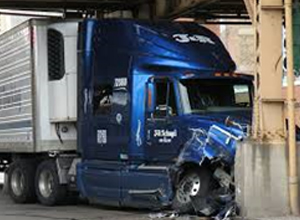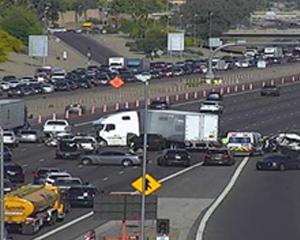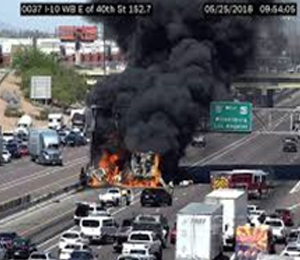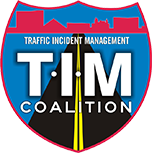
NEVADA TOWING & RECOVERY INCENTIVE PROGRAM (T.R.I.P.)
Background of program
TRIP is based on a comprehensive set of guidelines designed to ensure only well- trained, competent tow operators with proper heavy-duty equipment are dispatched to large commercial vehicle incidents that have a significant impact on major highway traffic, or if the response to the Commercial Motor Vehicle (CMV) crash has an impact to traffic. These guidelines replace long-standing policies that do not require modern hydraulic wreckers or formally trained operators. These new guidelines also require support equipment to address the prompt cleanup of spilled loads and vehicle fluids as well as the ability to participate in the required traffic control effort and utilization of scene safety devices. The current and established heavy rotational response to heavy crashes as outlined by the Department of Public Safety and that does not meet the TRIP response criteria will not be impacted by this program.


During the program’s pilot cycle, local towing and recovery companies have an open invitation to participate in this Program. Once the guidelines outlined in this document are met, a company may be added to the Program and if assigned, will become eligible to receive a monetary incentive for prompt response to an incident and quick clearance of the highway within established time parameters. Qualification for the program does not guarantee assignment of a recovery zone. Considerations for inclusion may include a rotation or backup status and will be based on the operational needs of NDOT. Smaller companies who do not fully qualify may partner with existing towing companies
Program Overview
TRIP’s key objective is the facilitation of safe and quick clearance of commercial vehicle crashes as well as large vehicle incidents through the improvement of towing standards, procedures, and training. This Program will improve incident management while building a mutually beneficial relationship within the towing community by making it more profitable for them to meet quick clearance goals. TRIP is designed to reduce the impact of major traffic incidents by establishing travel lane clearance goals of 90 minutes or less.
Program benefits
TRIP will benefit emergency responders, traveling motorists, and anyone concerned about traffic incidents in the region by facilitating the quick clearance of large commercial vehicle incidents, resulting in a reduction of congestion and secondary incidents.
Responders will benefit from increased safety with decreased time and exposure on the dangerous highways during incident clearance.
Motorist will benefit from more reliable travel times, increased safety through incident scenes, fewer emissions, and less fuel consumption. The entire region can benefit from the saved costs from reduced congestion and impacts from secondary incidents.
Towing and recovery companies will benefit from enhanced level of safety awareness, increased training opportunities, and from monetary incentives awarded for more efficient on-scene activities and meeting the performance goals of the program.

T.R.I.P resource information
Route Coverage Information
The Program will operate on the following highway routes.
I-15: Arizona to California border / mm 0.00 to mm 123
US95: Spaghetti Bowl N to Mercury interchange / mm 76 to mm 132cl
Note: The Mercury Interchange is in Nye County (7ny), but this is used as a reference point for TRIP and the towers.
US95: California border to I-11 / mm 0.00 to mm 55.81
US95 / I-515: Spaghetti Bowl to I-11 (Henderson) / mm 61.21 to mm 75.73
I-11: Arizona border to the Henderson interchange / mm 0.00 to mm 22.85
I-215: I-15 to I-11 (SE Beltway) / mm 0.00 to mm 12
SR160: SR159 to Mountain Springs/ mm 33 to mm 21
Note: LVMPD covers mm1 CL to mm 11CL
SR171: I215 to south edge of Airport Tunnel
Note: As this program is a Pilot Program, these areas of coverage may be adjusted dependent upon a NDOT request.
TRIP Training Requirements
- 1. Wreckmaster:
- a. Wreckmaster Level I – Operators This training is designed to educate and train the tow operator for the Wreckmaster Level 2/3 and partial of Level 4/5. Click on the link below to access information as well as dates of scheduled training.
Link: https://wreckmaster.com/hands-on-trip-1-course-description/ - b. Wreckmaster Level II – Supervisors This training is designed to educate and train the Tow Supervisor for the Wreckmaster Level 4/5 & Level 6/7. Click on the link below to access information as well as dates of scheduled training.
Link: https://wreckmaster.com/hands-on-trip-2-course-description/
- a. Wreckmaster Level I – Operators This training is designed to educate and train the tow operator for the Wreckmaster Level 2/3 and partial of Level 4/5. Click on the link below to access information as well as dates of scheduled training.
- 2. SHRP2 TIM Training:
- a. Contact David Strawn at PARSONS for further information at (702) 885-4944 or at david.strawn@parsons.com
- 3. NIMS (ICS™) Training
Here are some suggested training links. NVTIM is in no way affiliated with these with these trainings.- a. ICS™ 100 – See possible link for training: 1. FEMA – Emergency Management Institute (EMI) Course | IS-100.C: Introduction to the Incident Command System, ICS 100 [training.fema.gov]
- b. ICS™ 200 – See possible link for training: 1. FEMA – Emergency Management Institute (EMI) Course | IS-200.C: Basic Incident Command System for Initial Response, ICS-200 [training.fema.gov]
- c. ICS™ 700 – See possible link for training: 1. FEMA – Emergency Management Institute (EMI) Course | IS-700.B: An Introduction to the National Incident Management System [training.fema.gov]
- 4. Hazmat Awareness Training
Here is a suggested training link. NVTIM is in no way affiliated with this training. - 5. Nevada Basic Work Zone Training PowerPoint (Click to open)
TRIP Forms
TRIP Synopsis Report – Tow companies can click on this and then print the report.
TRIP Synopsis Sample Report – Tow companies can click on this and then print the report.
TRIP Invoice – Tow companies can click on this and then print the report.
TRIP Sample Invoice – Tow companies can click on this and then print the report.
TRIP Criteria List – Tow companies can click on this and then print the list.
Equipment List
Click the links below to download the list as a PDF.
TRIP AAR Meeting Schedule for 2024 (up to August of 2024)
The below information is for the TRIP After-Action Review meetings that will take place monthly. These meetings will review the prior month’s TRIP calls, review the program status, and to offer comments & suggestions to improve the functionality of the program. be a forum where those involved in the TRIP program; especially the Tow Companies, will have a voice to offer input to promote the success of the program. Other agencies may be invited to the meetings to offer other insights of TRIP activities and other details of the crash that may not be available by anyone else.
Please review below the meeting schedule for 2024
Location for all meetings, will be as follows:
Nevada State Police Highway Patrol / Room A105
Southern Command
4615 W. Sunset Rd
Las Vegas, NV 89118
Meetings Dates are as follows:
Date: January 11, 2024 (Held)
Time: 8:30am – 10:00am
Date: May 9, 2024
Time: 9:30am – 11:00am
Date: September 12, 2024
Time: 9:30am – 11:00am
Date: February 8, 2024 (Held)
Time: 8:30am – 10:00am
Date: June 13, 2024
Time: 9:30am – 11:00am
Date: March 14, 2024 (Held)
Time: 8:30am – 10:00am
Date: July 11, 2024
Time: 9:30am – 11:00am
Date: April 11, 2024
Time: 9:30am – 11:00am
Date: August 8, 2024
Time: 9:30am – 11:00am
Other meeting locations and times will announced.

